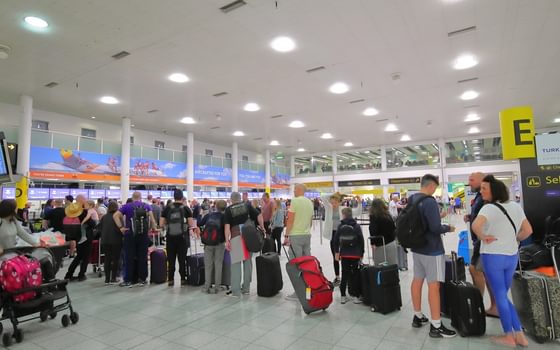Losing altitude
The economics of air transport in Great Britain
17 July 2023
The environmental downsides of growth in flight numbers are significant. The sector has no short-term technological solution to its greenhouse gas emissions; over the medium to long term, much uncertainty remains as to the pace of emissions reduction achievable. All scenarios published by stakeholders such as the Climate Change Committee, the Department for Transport (DfT), and air transport sector bodies, suggest that future air traffic growth would necessitate the use of costly, and unproven, carbon capture technologies.
Despite these risks, the government continues to provide conditional support to air capacity growth on the (often tacit) basis that the economic upsides outweigh the negative impacts and future risks. But, the economic assumptions that underpin this position favouring growth are dated and have not been reviewed for some years. Given the urgent and sizeable nature of the climate risk, it is imperative that the evidence, and relative balance, of the economic and environmental impacts of air transport growth are kept up to date and under constant review.
This report shows that since the government’s last comprehensive review of the economic impacts of air transport in 2012, trends in the British air transport sector have changed dramatically. Contrary to expectations, growth in business passenger numbers has effectively ceased and new passengers now derive exclusively from the leisure market. In particular, passenger growth has been driven by wealthy British residents rather than foreign tourists or those on lower incomes. Early evidence suggests the pandemic has accelerated this trend. This report reviews the current evidence on the impact of air transport growth across four core economic domains: welfare, jobs and wages, tourism, and wider facets of economic growth, business productivity, and trade.
The welfare impact of broad access to international travel (ie the experiences and relationships it enables), while challenging to quantify, brings social benefits to UK residents. As an argument for air capacity growth in the UK however, the welfare case is undermined by the share of new capacity which is typically captured by a small and wealthy subset of the British population while, each year, around half of British residents do not fly at all. Furthermore, the welfare benefit must now be offset against welfare losses resulting from greater environmental damage; these are substantial, as NEF has shown in prior work. Growth in air traffic implies a significant transfer of welfare from the majority, who suffer the ill effects of greenhouse gas emissions, noise, and reduced air quality, to a wealthy minority of frequent flyers.
Narratives around job creation in air transport often confuse the current footprint of aviation with the relative merits of growth. As a sector, air transport supports a large number of British jobs, but the amount of employment created by growth has been diminishing over time. The sector is, in fact, one of the poorest job creators in the economy per pound of revenue. It has achieved productivity growth through automation and efficiency savings, so much so that the rapid rise in passenger numbers seen between 2015 and 2019 was not sufficient to return direct employment to its prefinancial crisis peak in 2007.
Productivity growth in air transport has not translated into increased wages; after considering inflation, wages in air transport were significantly lower in 2022 than they were in 2006. This wage squeeze has been felt exclusively by middle and lower-paid workers, with real wages at the top seeing real-terms growth. Overall, between 2008 and 2022, air transport saw the largest real-terms pay decline of any sector in Britain and therefore worsened the country’s wider wage stagnation problem. The gains of productivity growth have accrued to higher-paid staff and shareholders.
Two decades of evidence now confirms that air transport growth runs counter to the interests of the UK’s domestic tourism industry. While the pandemic triggered a reprieve, before lockdown, domestic tourism expenditure had stagnated and instead, flows of cash were headed overseas as household spending patterns shifted towards foreign holidays. The net national effect is a large travel spending deficit which contributes to the UK’s overall current account deficit. While there is an argument that some of the cash which leaves the UK via outbound tourism may return in forms such as foreign direct investment (FDI) and lending, the trends described are unlikely to be positive for the health of the UK economy and its currency.
This negative diagnosis is reinforced by the regional dynamics of tourism spending flows. London and the South East see a travel spending surplus thanks to their receipt of the lion’s share of foreign tourist spending. The UK’s wider (and on average poorer) regions have seen their already significant travel spending deficits grow rapidly. To compound this trend, cash returning to the UK in the form of FDI also concentrates heavily in London and the South East. The current dynamics of British air transport are likely pushing against the government’s levelling-up agenda and domestic tourism objectives, yet these dynamics are actively encouraged by government taxation policy, which provides a competitive advantage to overseas holidaying.
The final core dimension of air transport’s interaction with the economy is its impact on wider business processes such as trade, investment, productivity, and ultimately gross domestic product (GDP) growth. Proponents of the sector have long argued that growth in air connectivity – and business passengers utilising that connectivity — drives improvement in various macroeconomic indicators. Contrary to the prevailing assumption underpinning the political and sectoral narratives, however, we do not find strong evidence of this link in contemporary Britain.
The research presents strong evidence that in less developed and less connected nations, air capacity growth can be a causal driver of economic growth. This relationship also appears to hold for nations with a strong inbound tourism bias such as Europe’s Mediterranean destinations. But in a nation such as the UK, already one of the best connected in the world, and seeing a strong outbound tourism bias, the case for growth appears to rely almost entirely on the presence of business air passengers. As net business air passenger growth has effectively ceased, the macroeconomic benefits of British air capacity growth appear to have diminished.
In support of this proposition are a limited number of academic studies, summarised in this report, which isolate the UK context from other developed and developing nations. These studies do not identify a causal link running from air capacity growth to economic/jobs growth in the UK. Furthermore, there are several comparable case studies, particularly from Germany, which highlight contexts in which air capacity growth can be detrimental to a region’s economic wellbeing, particularly when it comes to smaller regional airports.
This is not the first time the conditionality of air transport’s economic benefits on business travel and net positive tourism effects (both of which are absent in the UK in 2023) have been flagged. These were shared with the DfT in a report by academics from Leeds University in 2018,2 but the ramifications for modern air transport policy and planning appraisal appear not to have filtered through.
Recommendations
- The government should conduct a new, comprehensive, call for evidence and review of the economic case for the expansion of the UK air transport sector in terms of passenger departure and air traffic capacity.
- In light of the findings of this review, the government should consider the consistency of its air capacity policies with those of climate change, domestic tourism, and its levelling-up agenda.
- Given the proven and significant environmental damage delivered by air travel, set against uncertain and declining economic benefits, it might be prudent to pause airport expansion proceedings until said review has been completed.
- Economic impact analysis capacity at differentlayers of government decision-making should be improved. Delegated decision-makers, such as the Planning Inspectorate and local authorities tasked with appraising large and complex air transport proposals, should have greater access to economic training and independent technical support. This capacity would assist decision-makers in navigating several often misrepresented, opaque and/or ignored issues surrounding air transport appraisal, including:
- Ensuring comprehensive inclusion of all socioeconomic costs and benefits in economic impact assessments of air transport proposals, and application of welfare weighting to account for the equity of impacts (in line with the government’s Green Book).
- Scrutinising claims made around growth in business passenger departures and resulting productivity gains.
- Estimating and quantifying greenhouse gas emissions impacts in economic welfare impact assessments, according to government guidance.
- Ensuring routine measurement of the impact of proposed air transport growth on the flows and balances of tourism spending.
- Delivering consistent assessment of the displacement of impacts between sectors and regions and the presence of national-level impacts.
- Providing an expert opinion on the currency, relevance, and credibility of data cited on air transport’s economic benefits.
Image: iStock/Moonstone Images
Campaigns Stop airport expansions
Topics Climate change Environment Transport







